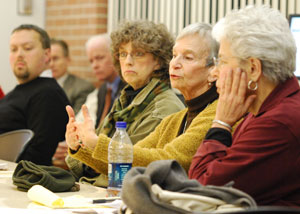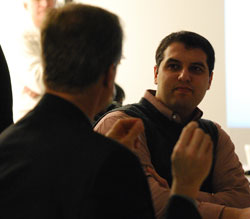Neighbors Weigh In Again on Wall St. Project

Eliana Moya-Raggio, a Wall Street resident and former UM faculty member, explains her objections to UM's proposed parking structure. She spoke at a Tuesday evening meeting held at the Kellogg Eye Center.
There were two distinctly different agendas on view at Tuesday’s Wall Street neighborhood meeting, hosted by University of Michigan staff. University representatives, led by Jim Kosteva, were there to deliver information about environmental and safety issues related to the proposed UM expansion in that area. The neighbors wanted answers to questions they’d been asking for many months – and their frustration was palpable.
This was the second in a series of meetings organized by UM to discuss the planned expansion of its medical complex with neighbors. The current piece of that project calls for an office building, parking structure and transit center on Wall Street, just down the street from UM’s Kellogg Eye Center.
Kosteva, UM’s director of community relations, repeatedly used the phrase “regentally authorized project,” and that was one of the first things challenged by neighbors at Tuesday’s meeting. In response to a question, Kosteva said that in fact the regents had taken the first of three steps: At their September 2008 meeting, regents gave initial authorization for the $48.6 million project and for hiring an architect. (Several neighbors were also on hand at that meeting, which The Chronicle covered, to speak against the project.)
At some point the regents will have to vote on approving a schematic design and a “refined” budget, Kosteva said, then at a later date they’ll vote on the project’s final design and budget. Sue Gott, a university planner, said the schematic design will likely be presented to regents at their March meeting.
Though Kosteva and other UM staff members repeatedly said they wanted feedback and would take the neighbors’ concerns into consideration as the project moved forward, residents on Tuesday were decidedly skeptical. As Kosteva finished his introductory remarks, one neighbor asked whether he planned to respond to questions and concerns raised at the November meeting, which focused on transportation issues, parking and the university’s planning process. She said the neighbors had hoped for a dialogue, but that based on Tuesday’s agenda, it didn’t appear that previously raised issues would be addressed, and that was disappointing.

UM's Jim Kosteva, left, makes a point to Eugene Daneshvar, a board member of Riverside Park Place condominiums.
Kosteva said the university staff was thankful and appreciative of all questions and concerns, which he said had caused the staff to analyze and reflect on their plans. But he said they did not intend to respond to those issues at this meeting. Gott said that at the February neighborhood meeting they planned to bring together everything they’d heard and roll it into a discussion then.
When pressed on whether this meant that there was room for negotiation of the medical system’s master plan, Kosteva responded that they were working under regental guidelines and have made adjustments based on feedback, but he did not specify what those adjustments had been. The master plan – which calls for eventually two parking structures along Wall Street and as much as 900,000-square-feet of additional office, clinical and research space – was first introduced in 2005, though the university has been talking about expansion in that area since the mid-1980s, Kosteva said. The street is already being transformed with the $121 million, eight-story expansion of the Kellogg Eye Center.
Several neighbors said they understood and even supported the medical system’s expansion – except for the inclusion of the parking structures.
Tim Mortimer, a board member for the Riverside Park Place condominiums, asked whether alternative sites had been considered for parking, such as land along Fuller that’s being considered for a city transit station, or a surface lot at the corner of Huron Parkway and Glazier Way. When it became clear that the answer was no – Kosteva said the university was working with the city on the Fuller site, but that the projects were on “parallel tracks” and wouldn’t eliminate the need for parking on Wall Street – neighbors responded with frustration.
Eliana Moya-Raggio said that the needs of the university weren’t the only factor – UM should also consider the solid opposition of the people who live in the area. “Who are we – are we nothing?” she asked. “Do people have no importance in this project of yours?”
Mortimer said the university had time and opportunity to look at alternative sites for parking, but that they just aren’t doing it. “You’re polite and courteous,” he said, “but you’re not listening.”
A major point of conflict is the fundamentally different goals that UM and the neighbors hold for that part of Ann Arbor. The university is trying to address the needs of its staff, faculty and patients who come to the medical complex. John Ballew, who manages facility planning for the UM health system, said that access to parking is crucial for employee satisfaction, retention and recruitment. He said that the health system’s staff – which the university expects to grow – wants parking that’s close enough for them to access their cars, especially for people who work off-hour shifts, have kids or dependent adults, or who move between the medical campus to other parts of UM during the day. He said the timing is uncertain for the city’s “multi-modal” station on Fuller, which is envisioned as a hub for light rail and bus.
Residents have a much different goal for Wall Street and the larger Lowertown area. Ray Detter, chair of the Downtown Area Citizens Advisory Council, read a section from the city of Ann Arbor’s master plan, which describes the vision for Lowertown as a “pedestrian-oriented urban village.” The influx of traffic from one or two large parking structures runs counter to that vision, Detter said.
Those disparate goals were also evident in the university’s presentation of crime statistics related to parking structures. David Miller, UM’s executive director of parking and transportation services, provided data on crime at UM parking structures on Glen, Ann and Catherine streets, and noted that parking structures in residential areas have far fewer crime incidents than those near businesses. (For those three structures, with a total of about 2,000 spaces, there were nine incidents in 2007 – four traffic accidents, three property damage incidents and two larcenies from vehicles.)
Sabra Briere, a neighborhood resident and Ward 1 city councilmember, said those statistics were important for people who used the parking structures, but were less valuable for people who live near them. Residents would be concerned about crime near the structure, or about bike/car and pedestrian/car incidents.
Mortimer described the proposed Wall Street parking structure as “the worst of both worlds.” The parking is far enough away from the medical complex to require that people take a bus from the structure to their destination. Yet it creates traffic congestion as people drive their vehicles to a parking structure in an urban neighborhood.
Moya-Raggio also remarked on the oddity of discussing environmental concerns – part of the university’s presentation was about how it planned to deal with various issues like air quality for its bus fleet – while at the same time encouraging people to drive by providing more parking. “It’s a paradox,” she said. Miller replied, “It’s complicated.”

Ray Detter listens to Sabra Briere, a neighborhood resident and city councilmember for Ward 1. The ward's other council representative, Sandi Smith, also attended Tuesday's meeting.
A couple of residents from Kessler Commons, another condominium complex on Wall Street, warned others of what they’ll face during construction. They said the university has ignored efforts to compensate them or deal with property damage and noise from the expansion of the Kellogg Eye Center. “You need to be aware of the scope of what’s coming,” said one resident, who asked not to be identified in this article.
When asked what the city was doing, Briere said the city’s staff was talking to the university’s staff, and that the mayor, John Hieftje, had managed to meet with UM President Mary Sue Coleman, “which was momentous to him.” She added that the council had passed a resolution to encourage that level of communication. But ultimately, she said, the city has no authority to do anything, other than to prevent the university from using the street.
Sandi Smith, who also represents Ward 1 on city council, said that UM officials need to respect the 2,000 residents in the area, and not create a plan that has no relation to the city in which the university exists. Celeste Novak asked whether it would be possible for neighbors to meet with city staff about what’s happening on Wall Street, and Briere said she could arrange a meeting, possibly at Northside Grill after the holidays.
The next neighborhood meeting with UM is on Jan. 27, when university staff plans to present a schematic design for the project.




With the University’s purchase of the Pfizer site, perhaps it is time for them to shift their development plans to the more accessible edges of the city and allow the Wall Street and Maiden Lane area to convert back to close=in residential uses that would support existing projects without increasing traffic congenstion in the center of town.
Thanks for the good coverage of this issue.